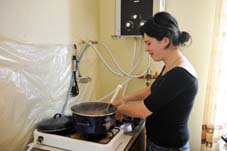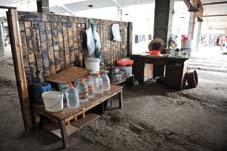Refugees of different eras endure different conditions
By Temuri Kiguradze
Wednesday, September 23

Many of these newer IDPs, just like those from the early 90s, lost their homes and almost all their property in the conflict which drove them to seek refuge, however the living conditions that the Government of Georgia has given the two groups of IDPs are quite different.
“We moved here from the Akhalgori district and for some time we had to live in a kindergarten in Tbilisi. However after several months the Government suggested that we could move to the refugee camp here and of course we agreed,” states 62 year Nunu Gigauri, who now lives in a cottage in Georgia’s biggest IDP settlement, Tserovani, 30 minutes from Tbilisi. This settlement, like the rest, was built on the central Government’s express order several months after the end of the August war. The cottages have electricity and natural gas connections and each household has been given a gas heater to prevent them freezing in winter, which can get quite cold in Tserovani. “Of course the conditions here are not perfect, but we are thankful for the Government for the assistance we have,” states Nana Kobakhidze, another refugee, whose two children attend the newly built Tserovani school which serves more than 1,000 kids from the IDPs camps close to Tserovani.
“Our school opened just a few days ago and President Saakashvili himself cut the red tape. We have selected the best teachers from the schools in Akhalgori and other occupied districts,” stated Ramin Chitashvili, the Tserovani School Principal. Speaking to The Messenger, he noted that the school has been constructed according to “European standards” and is “way better” than the old schools in Akhalgori district. “Thank God we have normal conditions to live in here, but of course the biggest problem among the refugees is unemployment. Only 40% of local residents are employed,” underlined Chitashvili.
Unemployment is the biggest problem for the “old” refugees as well. More than 60 families of IDPs from Abkhazia can only dream about the conditions of Tserovani. The only shelter they have is the half-decayed building of a former cotton factory in one of the Tbilisi suburbs. “There are more than 150 people living here, we have no pipes, no gas, and often face problems with electricity and water. The building we live in is not a residential building and it is dangerous, every day we see that new bits of wall have fallen down in the yard,” states Larisa Gasviani, who heads the administration of the community.

“As there are no pipes water flows right into the base of the building and it has become a nest of rats and insects. We have even seen some snakes dwelling there,” say the residents of the cotton factory. The only heating system available is a wood heater. “Wood is too expensive for me so I have to burn any wood I can find. Now I have prepared the remains of the parquet floor for the winter,” says one of the inhabitants, who stated he was “ashamed” to give his name to reporters.
“We know that people in the new settlements who were forced out from [South] Ossetia lost a lot during the war, but we are human too and we have lived in such conditions for more than 10 years. We need attention from the State. Why should we be treated like the animals just because we became refugees under a different Government?” stated Gasviani, who added that she and residents have addressed the Ministry with a request for the improvement of their living conditions but have received no answer.
